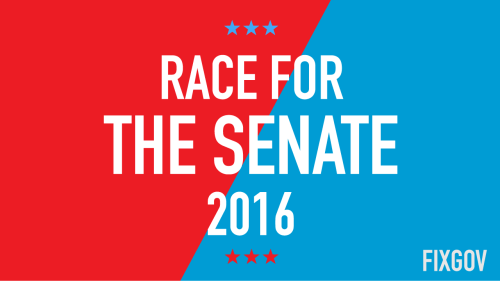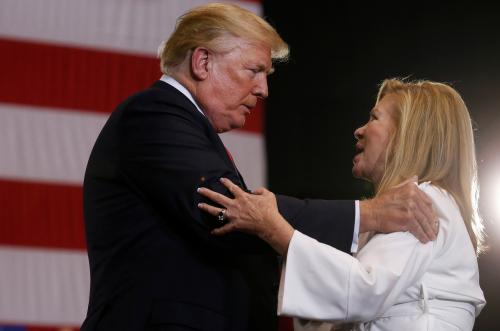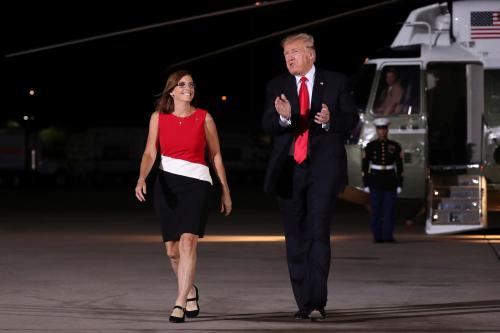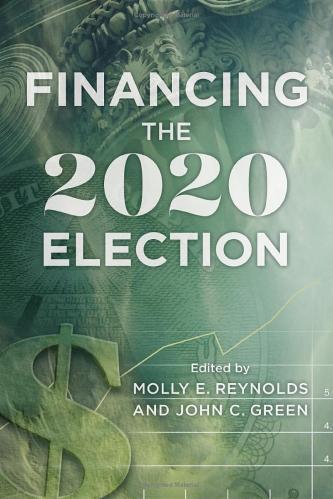This post is part of the series Race for the Senate 2018.
 For several years, the 2018 Indiana Senate race appeared to be tantalizingly low-hanging fruit to national Republicans. Why should Joe Donnelly, a Democrat, represent ruby-red Indiana and hold the seat previously held by senior Republican statesman Richard Lugar? Granted, Donnelly is a pro-life, tax-cutting moderate. But his elevation to the U.S. Senate in 2012 had more to do with who he wasn’t: his Republican opponent, Richard Mourdock, who stated in a campaign debate that “I think even when life begins in that horrible situation of rape, that it is something that God intended to happen.” That was a bridge too far, even for the Tea Party that Indiana Republicans had become.
For several years, the 2018 Indiana Senate race appeared to be tantalizingly low-hanging fruit to national Republicans. Why should Joe Donnelly, a Democrat, represent ruby-red Indiana and hold the seat previously held by senior Republican statesman Richard Lugar? Granted, Donnelly is a pro-life, tax-cutting moderate. But his elevation to the U.S. Senate in 2012 had more to do with who he wasn’t: his Republican opponent, Richard Mourdock, who stated in a campaign debate that “I think even when life begins in that horrible situation of rape, that it is something that God intended to happen.” That was a bridge too far, even for the Tea Party that Indiana Republicans had become.
Mourdock wasn’t running again in 2018. But Donnelly had other sources of good fortune. First, the two Republican U.S. House members attracted by the party’s Senate prospects—Luke Messer and Todd Rokita—each spent about $8 million mainly on ads attacking one another. Their advertising seemed to be successful; they knocked one another out of the Republican nomination race, which was won instead by the third candidate, Mike Braun, the multimillionaire owner of an auto parts distributing company. Like Donald Trump, Braun self-funded his primary campaign. That bolstered his claim that he wasn’t “beholden to Washington,” but it also deprived him of the electoral benefits of giving thousands of voters an investment in the success of his campaign. And to this point in the general election, Braun’s “sleepy campaign…[is] leaving Republicans underwhelmed—and worried,” according to Brian Slodysko of the Associated Press.
The one part of the Braun campaign that hasn’t been sleepy are his broadcast ads. Backed by a massive onslaught of advertising from Sen. Mitch McConnell’s Senate Leadership Fund PAC and other outside groups expected to total almost $20 million by Election Day, Braun presented himself as a kind of blue-collar Trump: a denim-wearing industrialist who understood his workers’ needs and smiled benevolently at them on the shop floor. His ads lambasted Donnelly’s brother’s firm for outsourcing jobs to Mexico (a claim disputed by PolitiFact) and assailed Donnelly himself as a tax-loving, radical-leftist friend of Chuck Schumer. Like Trump, Braun gave his opponent nicknames, ranging from “Mexico Joe” to “Sleepin’ Joe.” But Braun’s identification with Trump had a cost. The Indiana Chamber of Commerce, unimpressed with the Trump/Braun support for tariffs, refused to endorse either Braun or Donnelly, after years of endorsing Republicans only, and the U.S. Chamber did not announce its endorsement of Braun until late September.
Donnelly’s ads have responded in kind. The senator displayed packages shipped by Braun’s trucking and distribution companies to show their “made in China” label. To underscore his credentials as a moderate, Donnelly showed footage of Trump praising his efforts. In fact, he ran a controversial ad in mid-October distancing himself from liberals by touting his support for Trump’s border wall and sharply criticizing the “radical left” for wanting government-run healthcare and the abolition of ICE.; policies that would be enacted “over my dead body,” according to Donnelly.
Understandably, Donnelly’s advertising outraged many Hoosier liberal Democrats. Although it isn’t unusual for moderate Democrats in the Hoosier state to portray themselves as middle-of-the-road, Donnelly’s criticism of the “radical left” has been more pointed than most Democratic candidates’, and his references to Trump and Ronald Reagan have been more frequent. He tried to balance these appeals with an announcement that, as liberals had insisted, he would vote against Brett Kavanaugh’s nomination to the Supreme Court. But trying to keep the votes of Trump-hating Democrats while at the same time demonstrating his conservative credentials to Trump-loving Republicans is a challenging task, especially at a time when negative partisanship runs deep. And the bottom line for Donnelly is that even if every Hoosier Democrat votes for him, he would still lose reelection without at least some Republican support.
Many question marks remain in the race. Indiana farmers have been hard hit by the Chinese backlash against Trump’s tariffs, but the president’s aid package to offset these losses gives soybean farmers the biggest share, rather than the state’s corn growers. Farmers and other rural voters contributed to President Trump’s 19-percentage-point victory in Indiana in 2016. Will these Republicans blame Trump for their troubles, or will they attribute their economic losses to globalism and the Deep State? Will outside spending attacking Donnelly ramp up in the closing days of the campaign, though Donnelly has maintained an edge over Braun in the candidates’ own fundraising? Researchers have shown that negative advertising (which characterizes most outside groups’ ads) is conditional in its impact. But to the extent that negative ads tend to be more memorable, and in an election year awash in political stimuli, a last-minute surge of attack ads by Republican-leaning groups could work to Braun’s advantage.
Overall, however, the most impactful element of the Braun-Donnelly campaign is the “D” on the ballot associated with Donnelly’s name. Indiana has a history of electing moderate to conservative Democrats in the tradition of Evan Bayh—fitting for a state whose population often expanded with southerners and Appalachians moving north rather than northeasterners moving west. But this tradition has been slipping into history; statewide Democratic candidates have failed to win recent elections, and Bayh himself lost his bid for a return to the Senate in 2016. Republican dominance has entrenched itself in the state legislature through gerrymandering; Democrats now constitute 18 percent of the membership of the state senate and 30 percent of the state house, though the Democratic state legislative vote in Indiana usually averages about 40 percent. So, Joe Donnelly has the unenviable challenge facing any moderate Democrat in these polarized times: trying to find and hold the center in a state whose politics is defined more and more by activists on the extremes.









Commentary
Race for the Senate 2018: Key issues in Indiana
October 29, 2018